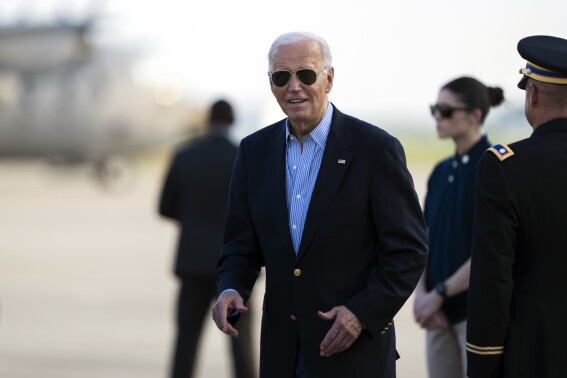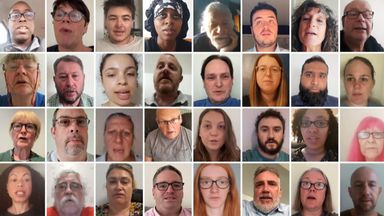SACRAMENTO, Calif. (AP) — Forced labor, same-sex marriage and shoplifting are among the 10 statewide ballot measures that California voters are set to consider in November.
The California secretary of state assigned proposition numbers to the measures on Wednesday after the Legislature added two more bond proposals to the ballot.
Here’s a look at what voters will decide in November:
Proposition 2
This asks voters for permission to borrow $10 billion for public school construction and repairs. Most of the money, $8.5 billion, would go to elementary and secondary schools. The rest, or $1.5 billion, would go to community colleges. No money would be available for the California State University or University of California systems.
Proposition 3
This would remove the ban on same-sex marriage from the California Constitution. Voters added that ban to the constitution in 2008. But the U.S. Supreme Court has prevented California from enforcing the ban since 2013. Still, the language banning same-sex marriage remains in the state constitution. The proposed amendment would remove the ban and replace it with language saying, “The right to marry is a fundamental right.”
Proposition 4
This asks voters for permission to borrow $10 billion for various climate programs. The largest chunk of the money, $3.8 billion, would help pay to improve drinking water systems and prepare for droughts and floods. Programs preparing for wildfires would receive $1.5 billion while programs combating sea level rise would get $1.2 billion.
The rest would be divided up among parks and outdoor recreation programs, clean air initiatives and programs preparing for extreme heat, protecting biodiversity and helping make farms and ranches sustainable.
Proposition 5
What to know about the 2024 Election
- Democracy: American democracy has overcome big stress tests since 2020. More challenges lie ahead in 2024.
- AP’s Role: The Associated Press is the most trusted source of information on election night, with a history of accuracy dating to 1848. Learn more.
- Read the latest: Follow AP’s complete coverage of this year’s election.
This would change the state constitution to make it easier for local governments to borrow money, provided they use the funds to build affordable housing or public infrastructure. Local governments, excluding school districts, currently can borrow money only if two-thirds of voters approve.
This would lower that threshold to 55% for affordable housing and public infrastructure projects. Public infrastructure includes water and sewer systems, public transportation, libraries, broadband internet and hospitals.
Proposition 6
This would change the California Constitution to ban forced labor in any form. The constitution currently bans involuntary servitude, or forced labor, except as a punishment for crime. That exemption has become a target of criminal justice advocates concerned about prison labor conditions. It is not uncommon for people who are incarcerated to be put to work earning less than $1 an hour.
Proposition 32
This eventually would increase California’s minimum wage to $18 per hour. It is currently $16 per hour for most people and $20 per hour for fast food workers. Health care workers will eventually see their minimum wage reach $25 per hour, according to a law that Democratic Gov. Gavin Newsom signed last year.
Proposition 33
This would repeal a state law prohibiting cities and counties from capping rents on single-family homes, condominiums and apartments built after 1995. Supporters say the proposal would help prevent homelessness.
Similar measures failed in 2018 and 2020 amid fierce opposition led by landlord groups and the real-estate industry. Opponents argued the proposal would hurt mom-and-pop landlords and discourage the construction of affordable housing.
State lawmakers in 2019 approved a 10% statewide cap on annual rent increases. The law exempted new construction for 15 years and is set to expire in 2030. Several cities including Los Angeles, San Francisco and San Jose also have local rent control policies.
Proposition 34
This would permanently allow California’s Medicaid program to pay pharmacies directly for prescription drugs. California started doing this in 2019 after Newsom signed an executive order allowing the payments. This measure would make it a law.
The measure also would require some health care providers to spend almost all of the money they get from a federal prescription drug program directly on patient care instead of other things.
This proposition appears to be directed at the AIDS Healthcare Foundation. The measure has the backing of the California Apartment Association, which helped pay for an ad criticizing the AIDS Healthcare Foundation. The foundation has said it is being targeted for its support for rent control.
Proposition 35
This would make the state pay doctors more money for treating patients who are covered by Medicaid, the government-funded health insurance program for people with low incomes.
Managed care organizations contract with the state to provide these health benefits. The state taxes these organizations to help pay for the Medicaid program. This measure would require the state to use a portion of that tax money to increase how much Medicaid pays doctors.
Proposition 36
This would make the crime of shoplifting a felony for repeat offenders and increase penalties for some drug charges, including those involving the synthetic opioid fentanyl. It also would give judges the authority to order those with multiple drug charges to get treatment.
Proponents said the initiative is necessary to close loopholes in existing laws that have made it challenging for law enforcement to punish shoplifters and drug dealers.
Opponents, including Democratic state leaders and social justice groups, said the proposal would disproportionately imprison poor people and those with substance use issues rather than target ringleaders who hire large groups of people to steal goods for them to resell online.
What to know about the 2024 Election
- Democracy: American democracy has overcome big stress tests since 2020. More challenges lie ahead in 2024.
- AP’s Role: The Associated Press is the most trusted source of information on election night, with a history of accuracy dating to 1848. Learn more.
- Read the latest: Follow AP’s complete coverage of this year’s election.
Disclaimer: The copyright of this article belongs to the original author. Reposting this article is solely for the purpose of information dissemination and does not constitute any investment advice. If there is any infringement, please contact us immediately. We will make corrections or deletions as necessary. Thank you.



